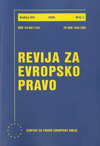THE CHARTER OF FUNDAMENTAL RIGHTS OF THE EUROPEAN UNION: SEEN FROM AFAR, SEEN FROM WITHIN THE EU
THE CHARTER OF FUNDAMENTAL RIGHTS OF THE EUROPEAN UNION: SEEN FROM AFAR, SEEN FROM WITHIN THE EU
Author(s): Rainer FaupelSubject(s): Law, Constitution, Jurisprudence, Human Rights and Humanitarian Law, EU-Legislation
Published by: Удружење за европско право - Центар за право Европске уније
Keywords: European Union; Charter of Fundamental Rights of the European Union; Nice Summit; Laeken Summit; Laeken Declaration; future of the European Union; Constitution of the European Union
Summary/Abstract: The paper gives an assessment of the Charter of Fundamental Rights of the European Union as proclaimed by the Nice Summit in December 2000. It is argued that the Charter in spite of its lack of legally binding force and in spite of the fact that its contents, compared with other legal instruments dealing with human rights matters, essentially constitute nothing really new is of great importance, both in substance and in the way is was developed by a ′Convention′. The Charter can be seen as the human rights part of a future Constitution of the European Union and thus form a crystallizing core or catalyst for a new or continued discussion on such a Constitution. The many open questions in the European Union - competences between the Union, the member states and the regions; balance of power between the institutions of the Union; decision-making procedures, majority rules and vetoing-rights in an ever-growing Union - cry for new answers which at the same time can do something against a strongly felt democracy and legitimacy deficit. The Laeken Declaration, adopted by the European Summit in December 2001 and creating a new ′Convention′ to answer those questions, is very much influenced by the Charter experience and expressly mentions the possibility of a Constitution for the Union with the Charter as a part that Constitution.
Journal: Revija za evropsko pravo
- Issue Year: 3/2001
- Issue No: 1
- Page Range: 23-44
- Page Count: 22
- Language: English

